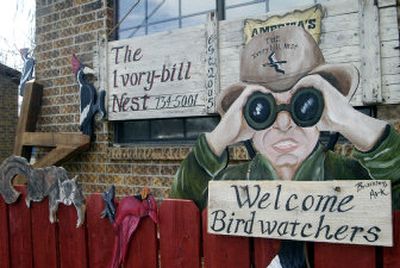Not-so-extinct woodpecker fills the bill for town

BRINKLEY, Ark. – If the ivory-billed woodpecker is getting a “second chance,” as U.S. Interior Secretary Gale Norton put it, then so is the depressed part of Arkansas where the bird was rediscovered after being thought extinct for 60 years.
The Brinkley area, where poverty is prevalent and agriculture the mainstay, has become a tourist destination in the year since Cornell University researchers made the announcement. The town is holding a celebration of the bird this week.
“It’s been like a shot in the arm for us,” said Sandra Kemmer, executive director of the Chamber of Commerce in Brinkley, a town of about 4,000 halfway between Little Rock and Memphis, Tenn. “People are coming from all over.”
Lisa Boyd has opened The Ivorybill Nest, a gift shop that sells souvenirs with the bird’s image emblazoned on everything from shot glasses to T-shirts. An ivory-bill door knocker announces visitors.
“I guess I’ve got the only ivory-billed gift shop in the world,” Boyd said. Visitors from as far as Argentina and Germany have signed her guest book.
The Mallard Pointe Lodge in Brinkley reported a 30 percent increase in visitors since the bird’s discovery.
This week’s celebration includes presentations by those who have seen the ivory bill. Gene Sparling, who caught a glimpse of a large woodpecker in a nearby wildlife refuge in February 2004 and notified researchers, speaks tonight.
The celebration includes merchant booths and guided bird-watching tours, though few expect to see the elusive ivory bill.
Brinkley is the largest city in Monroe County, where 30.9 percent of people lived at or below the poverty level in 1999, the most recent figures available. Rice and soybeans drive much of the economy.
Birders come just to be near the area where the woodpecker was found, said Bob Odear, a birder and tour guide operator from Tennessee. Even if they don’t see the ivory bill, they come away satisfied by the beauty and the other birds of the area.
“It’s a bird that has stirred the imagination,” Odear said. “They know they haven’t got a chance in the world of seeing it, but in birding, there’s no such thing as a sure thing.”
Birders will keep coming to Brinkley despite the slim chances, Odear said. His company, Observ Tours, has had inquiries from England, Germany, the Netherlands and Sweden.
The woodpecker is in no danger even if droves of birders come to Brinkley, said Jay Harrod of the Nature Conservancy.
“The big woods are very vast, and right now those same woods where the bird was found support thousands of duck hunters every year,” he said. “So an increase in birders or outdoor enthusiasts wouldn’t have a negative impact on the bird.”
The area covers 550,000 acres, or about 860 square miles.